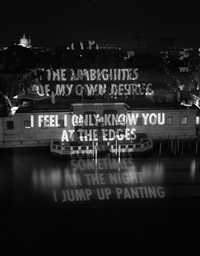written by:Desere’ Carlson

Education
Beth Cavener is a full-time studio sculptural artist based in Montana who makes her large life-like animal pieces out of clay. She has a BA in sculpture from Haverford College and an MFA in ceramics from Ohio State. She was awarded the artist trust fellowship in 2009. She fondly remembers her first career aspirations to become a scientist like her father and although she did not continue on that path she carries with her her dads inquisitive thought process. It’s his teachings to ask more direct questions that prompts her to understand deeper meanings behind human behavior. She has created a professional studio space or “think tank” called Studio 740 where emerging artists can apply for a space for a period of time. The studio allows artists to connect collaboratively, bounce ideas off one another, and just be able to explore the creative process among other creatives all while adding to their body of work.

Premonition, 1999 stoneware, 12 x15 x10 in.
Inspiration
“The sculptures i create focus on human psychology, stripped of context and rationalization, and articulated through animal and human forms. On the surface,these figures are simply feral and domestic individuals suspended in a moment of tension. Beneath the surface they embody the impacts of aggression, territorial desires, isolation, and pack mentality.”
Beth’s body of work has intensely Baroque sculptural roots that draw the viewer into the drama of the sculpture. The sweeping motions of the fur on her animals offers a modern twist of a whimsical fairytale her sculptures seemed to have jumped out of. Her attention to detail captures the intense emotional state of the creatures she sculpts making them appear human in their emotional vulnerability. Cavener is careful in her incorporation of human expression and gesture as well as sometimes incorporating human genitalia, aiming to blur the lines between human and animal behavior. Her pieces often deal with those uncomfortable feelings we all experience such a anger, fear, helplessness etc. portraying them through animal bodies allowing the viewer to take on these otherwise touchy subjects as if they are at the base of their carnal roots.
“I rely on animal body language in my work as a metaphor for these underlying patterns, transforming the animal subjects into human psychological portraits.”

Process
To make one of these sculptures, Cavener first builds a solid form on armatures. She then cuts the sculpture into sections; hollowing out each section as she goes. She them combines the smaller cut sections back together- leaving them in larger sections (such as a full leg) and then fires them in the kiln. Following the firing of the larger reassembled pieces, she assembles the sculpture in its entirety. After refining details, painting solid washes or elaborate details on the figures may be the finishing touches she adds to a piece.


The Question that Devours, 2012 stoneware/paint, 64 x 35 x 25 in



















